
There’s something inexplicably fun about flicking wooden discs across a table. If you’ve played dexterity games like Crokinole or PitchCar you’ll know what I’m talking about. All the planning and strategy in the world won’t save you if you’ve simply got bad aim. On the other hand, just having good aim isn’t enough if you don’t know what you’re shooting for.
Here are two games I’ve discovered recently that put your flicking finger to work, and they’re both terrific: Catacombs is an RPG-style dungeon crawl and Knights of Crylail is a simpler shuffleboard-inspired game.
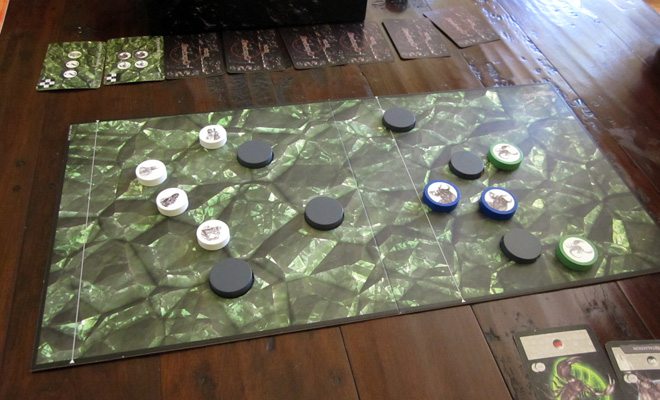
 Overview: Stop me if you’ve heard this before: in the game Catacombs, you are a team of brave souls (barbarian, elven archer, thief, and wizard), fighting your way through a series of catacombs filled with monsters, with the ultimate goal of finding and defeating the Catacomb Lord. Oh, and there aren’t any dice. Instead, you fight the baddies by flicking wooden discs at each other. Intrigued?
Overview: Stop me if you’ve heard this before: in the game Catacombs, you are a team of brave souls (barbarian, elven archer, thief, and wizard), fighting your way through a series of catacombs filled with monsters, with the ultimate goal of finding and defeating the Catacomb Lord. Oh, and there aren’t any dice. Instead, you fight the baddies by flicking wooden discs at each other. Intrigued?
Players: 2 to 5
Ages: 12 and up (though you could probably go a bit younger)
Playing Time: 30 to 60 minutes (though I’d err on the longer side)
Retail: $55.00
Rating: Like I said in the title, Catacombs is flickin’ awesome. Lots of fun with a combination of strategy and dexterity.
Who Will Like It? If you like the theme of D&D but you want something you can pick up and play in an hour (without all that dice-rolling) — or even if you do play D&D regularly — Catacombs is worth your while. In fact, it might actually make a good gateway game into D&D. If you’ve enjoyed other dexterity games or just like flicking things around the table, you should definitely check this out.

Theme:
Like I said, it’s not a new theme. Four heroes versus room after room of monsters, ending (if they survive that long) with a climactic battle against one of the four Catacomb Lords. You’ll face living skeletons, trolls, orcs, giant scorpions, minotaurs, fire spirits, and zombies. You’ll collect gold by killing monsters, which you can spend to buy useful items from the Merchant or more health from the Healer. Each of the four heroes has different stats and abilities which will come into play.
The fact that all of the action takes place by flicking little wooden discs doesn’t make it any less exciting or intense than an encounter in an RPG. In fact, that element of physicality might make it even more realistic — can you really hit that monster who’s hiding behind the pillar? Should you charge into the fray or stay behind cover and shoot an arrow? In fact, it’s reminiscent of the way that battles take place in True Dungeon, though on a smaller scale.
What you will find that — perhaps surprisingly — you really get into the game while playing. I suppose the mechanic of shooting little wooden discs around a board is no less “realistic” than rolling a d20 when it comes to fighting monsters.
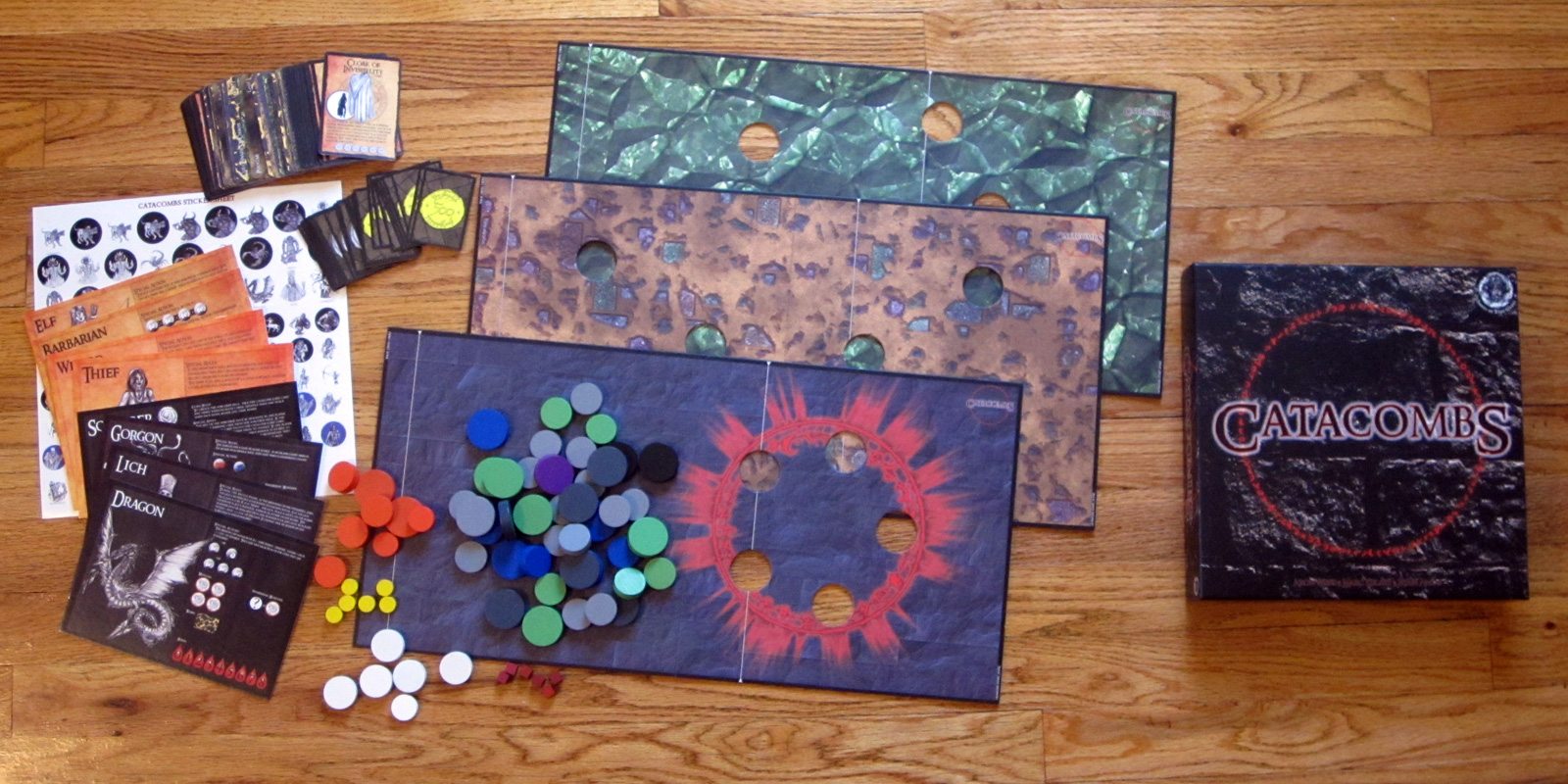
Components:
Sands of Time Games managed to pack a lot of stuff into this box:
- 3 double-sided game boards
- 8 player mats (four heroes, four Catacomb Lords)
- 12 wizard spell cards
- 9 item cards
- 38 room cards
- 13 monster cards
- 40 small currency cards (in 100 and 500 denominations)
- 62 wooden discs in 4 different sizes and several colors
- 6 red wooden cubes (for tracking hit points)
- 1 sheet of stickers for all the discs and instructions for applying them
From what I understand, their first printing had some problems with mold on the wooden discs but this second printing is using a different process that should resolve that. (Just in case, though, I’m keeping that little bag of silica gel in the box.) The wooden discs are pretty nice, though, about 3/8″ thick and in varying diameters. They’re a pretty good size for flicking. Some of the smaller discs representing missiles of different sorts are thinner and pretty tiny, so you’ll want to keep a good eye on those if you have somebody who tends to power-flick.
The boards are long rectangles, each with five or six holes which hold large grey discs that represent obstacles in the room, and the backgrounds are really nice. Even though it’s essentially the same layout when you flip it over, there’s a different background and the direction is changed (that is, the heroes start on the opposite end) so in some instances the heroes have better cover on one side and the monsters have better cover on the other. The cards have a matte finish and a nice texture, though they also have a tendency to curve slightly. The player mats are a thick cardstock and they’re okay, but probably a thick cardboard tile would have been nicer because these are also slightly curved and don’t sit perfectly flat on the table, which makes it easy to disturb the cards and shift the little wooden cube representing the hit points.

The only thing I wasn’t especially impressed with was the artwork on the game. Now, I’ve never done any illustrations for a game and I’m certainly not saying that I could do a better job drawing warriors and beasts. But the illustrations are pen-and-ink drawings which look, well, a bit amateurish. It’s a weird juxtaposition with the well-done logo and graphics and the backgrounds on the boards themselves. For the stickers on the discs, it’s not really much of an issue because they’re pretty small, but on the player mats there are large illustrations of the boss monsters and heroes, such as the Gorgon pictured above and the Barbarian below. It doesn’t affect the gameplay, of course, but it just really wasn’t my style.
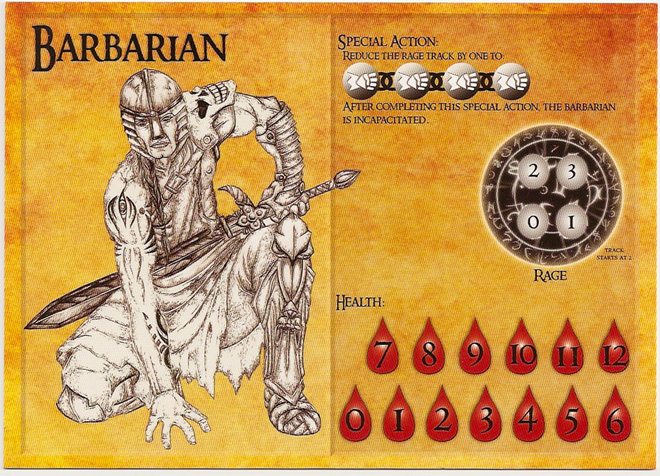
Gameplay:
Ah, the gameplay! Here’s where it gets fun.
One player is the Overseer, who sets up the rooms and controls all the monsters. The rules give a basic setup with the order of Level 0, Level 1, and Level 2 rooms, plus a merchant and a healer, and then ending with the Catacombs Lord. The player can decide which boss they want to face this game, which also determines the “wandering monsters” for the other rooms.
The rest of the players divide up the four heroes amongst themselves however they see fit, but you always use all four heroes. Each hero gets a player mat and places the red cube on the maximum hit points. The Wizard also receives the spell cards and a few tokens representing those, and the Elf receives two small yellow discs that represent arrows she can shoot.
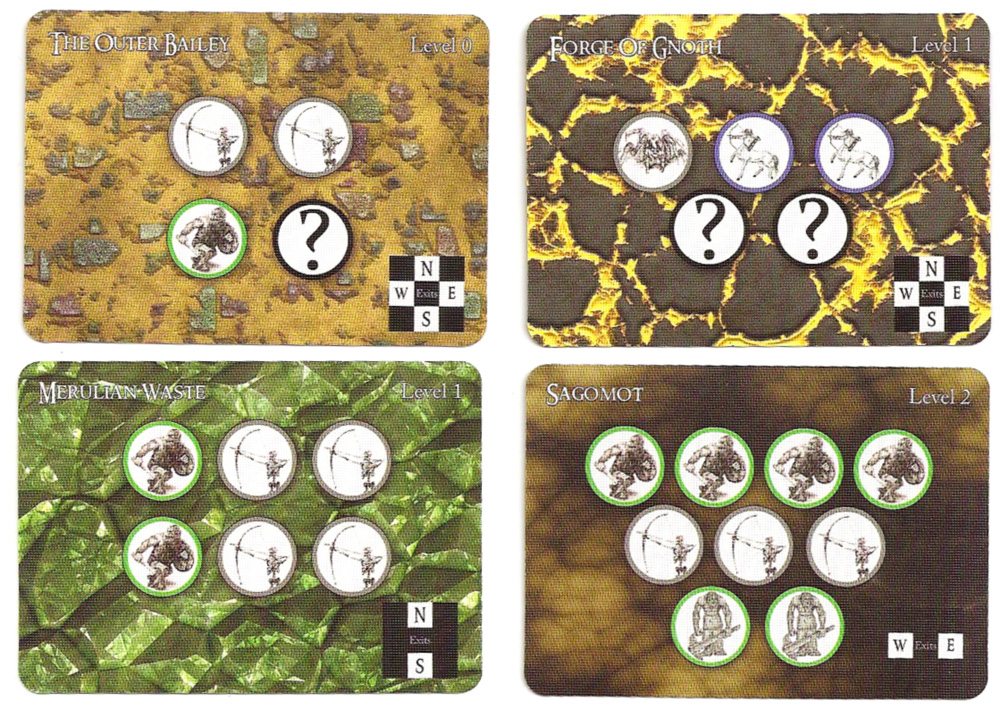
The heroes enter the rooms in order, and when the room card is revealed it shows which board to use and what monster tokens will be present. Question marks represent wandering monsters, which are determined by the choice of Catacomb Lord. The heroes start on one end of the board behind a white line (basically they’re right up on the edge of the board). After they’re in place, the Overseer then places the monster discs wherever they want, and then heroes get to move first.
First all the heroes get to take one action each in any order, and then each of the monsters gets to take their actions. The game continues until either all the monsters or all the heroes are killed. Once all the monsters are killed then the heroes flip the next room card and continue.

There are two basic moves: melee attacks and missile shots. For a melee, you flick the actual hero or monster toward your target, and hitting them inflicts damage. For missile shots, you place a smaller disc within an inch of the shooter and flick that instead. All of the heroes can use a melee shot, but the Elf can also choose to shoot up to two arrows per room. The Thief’s ability is that if she misses on her melee shot, she can move again but does no damage, which allows her to take a shot and then hide (or reposition) if she misses. The Wizard has various spells that can be cast instead of using a melee attack, but each card can only be used once in the game and is then discarded. He has more than one of some of the spells, such as the Fireball missile shot, but only one of others like Teleport. There is no friendly fire, but you can ricochet a disc off several targets in one go.

All of the monsters besides the boss have only one or two hit points, but some also have pretty scary abilities. All of the stats and abilities are shown on the monster cards. The Troll regenerates, so that if you only get one hit on him in the hero phase, he gets his health back. The Cerberus can move and shoot two missile shots, so it can do a lot of damage in a single turn. There are various other special traits on some of the monsters which are explained in the rules.
After a room is complete, heroes collect gold for the monsters they’ve killed (the amount per monster is listed on the monster cards). The money can be spent when the heroes reach the merchant, who randomly draws six of the nine available cards for them to purchase.
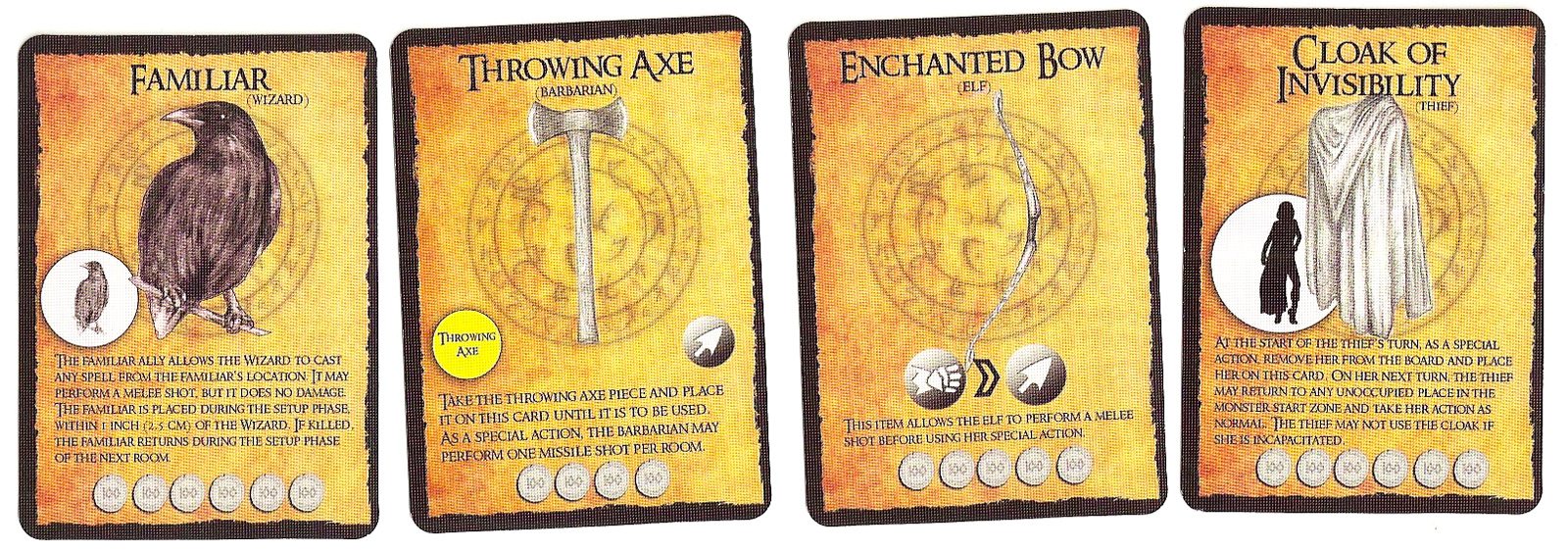
Many of the items are tied to a particular hero, with two choices for each one; the last item, a Map, allows the heroes to reveal all of the room cards so they know what’s coming. Each of the items grants some pretty useful abilities. The Wizard can get a familiar, a small crow disc which he can send into a room and then cast spells from its location, keeping himself safe. The Barbarian can get a throwing axe to have one missile shot per room. The enchanted bow allows the Elf to take a melee shot followed by a missile shot, which can be quite handy for getting into position or doing double damage. The Thief’s cloak of invisibility basically allows her to teleport to another location on the board. Other items include a chain lightning spell, a helmet of rage, a magic quiver, and a poisoned knife.
There’s a healer that appears toward the last few rooms, and the heroes have an opportunity to regain hit points or even resurrect a fallen hero, but it costs quite a bit of gold.
At the end, of course, is the big boss. Each of the four Catacomb Lords comes with a set of minions and some powerful abilities. The Gorgon has a gaze of stone which can stun a hero or instantly kill a stunned hero. The Dragon can spawn fire spirits and can also shoot fireballs. The Sorcerer is harder to hurt — he starts with only a few hit points, but when you hit him you might not actually cause any damage. The Lich summons up hordes of the undead. Finish off the boss, and the heroes win the game! If not, then the Overseer is triumphant and can cackle maniacally.
Conclusion:
Catacombs is a lot of fun. I took it with me back in May while I was visiting fellow GeekDad Dave Banks, and although we only got to play it once then, we both really enjoyed it and I think he’s hooked now. Like I said, I’m not a big fan of the artwork, but I’m also quite willing to look past that for the excellent gameplay experience. The different abilities of the four heroes really makes them behave differently, even though they’re essentially the same little white discs. You’ll have the wizard hiding at the back throwing spells, the thief charging in and back out again, the elf positioning herself to shoot arrows, and the barbarian charging into battle.
It takes a little practice and trial-and-error to figure out how to best place the monsters. Dave realized after a few rooms that hiding behind the pillars worked best since the heroes get the first turn, and I’d often be able to wipe out a lot of monsters on my first round. There’s some luck involved in the room setup, because if you happen to get really tricky monsters it gives the Overseer an advantage; if you end up with a lot of Zombies then they’re not quite as useful and the heroes will plow through them. After our first game I felt that the game was a bit unbalanced in the heroes’ favor … until I managed to demolish another set of gamers as the Overseer myself. Since then I’ve played a couple more times and each time all the players have really had a blast.
It’s fun to have several players controlling the heroes, because then they can discuss strategy and try to plan their attacks. It’s definitely a game where you’ll find yourself cheering out loud for a really great flick (even if it damages you) or groaning when somebody totally biffs a shot. The pillar obstacles on the boards are a key element — without them it would be much easier to just flick back and forth, but they change up the rooms and give you something to maneuver around (or behind, if you’re a cowering Wizard).
One thing that I’m waiting on is more explanation of the “exits” shown on the room cards. The rules state that these are for variant play, but I didn’t see anything yet on how to use them. What it looks like, though, is that you could probably set up an actual maze of rooms rather than just a linear start-to-finish, and let the heroes choose what direction they want to go after any given room. It allows for a lot of flexibility, but hopefully Sands of Time Games will release some official rules for these soon.
I don’t have a lot of games that have a really physical element to them, but it’s fun to get people standing up around a table and getting into the best position to take a shot, rather than just sitting down. Whether you’re a diehard D&D player or somebody who just wants to get some quick dungeon action, Catacombs is a tremendous amount of fun.
The second printing should be available very soon (late June or early July) from online retailers and your friendly neighborhood game store, along with two expansions: the Dark Passages mini-expansion and a pretty massive Caverns of Soloth which introduces a horde of new monsters, heroes, Lords, and items. I can’t wait!
Disclosure: GeekDad received a review copy of this game.
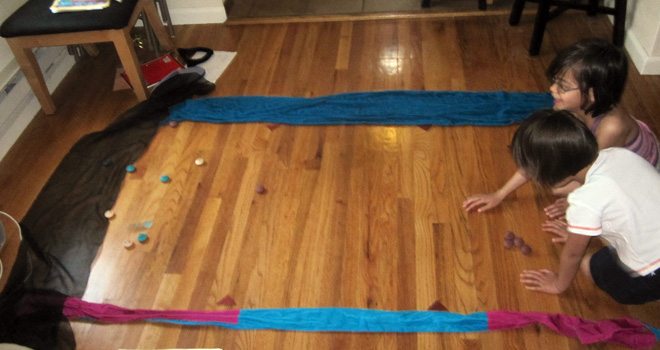
Overview: A dark wizard has summoned three Drak-Borgs and set them at the edge of the Void — and when each Drak-Borg falls to its death, the wizard gains power. The knights of Crylail have joined forces to slay the Drak-Borgs, but beware the Void! All that is to say, you get to flick some wooden discs at other wooden discs, without falling off the edge of the table. Knights of Crylail isn’t a new game, but one I happened to come across recently.
Players: 2 or 4 (on teams)
Ages: 13 and up according to manufacturer, but really you could play this with much younger kids
Playing Time: 15 to 45 minutes (adjustable based on scoring goal)
Retail: $25.00
Rating: +5 to Dexterity! Knights of Crylail is something between shuffleboard and bocce, and it’s a lot of fun.
Who Will Like It? Who wouldn’t like shooting wooden discs across a table? This is one of those games that you’ll get out for a quick filler and then end up playing the rest of the night.
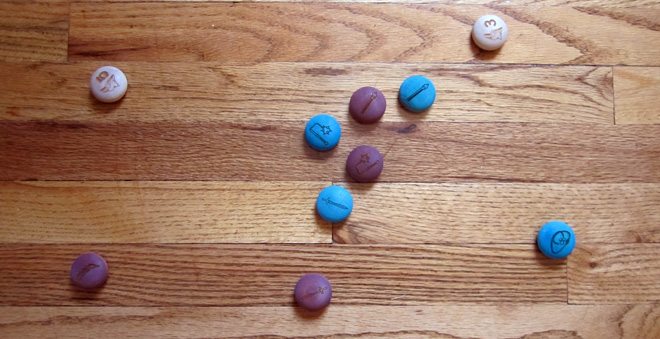
Theme:
Okay, I’ll admit that the theme is a bit weaker than Catacombs. It’s a pretty roundabout story with lots of plot holes: why does the wizard need the Drak-Borgs to fall into the Void to get power? How come he doesn’t get power if the Drak-Borgs are slain? What are Drak-Borgs, anyway?
Basically, the story is a roundabout way to explain why you want your discs as close as possible to the Drak-Borgs, but you don’t want to simply knock them off the edge.

Components:
The game is very compact, and comes in a nice little metal tin. It includes a bunch of discs: 3 Drak-Borgs, and 12 player discs (6 of each color). There are also four wooden triangles for marking boundaries, and some instructions. My set (found in the sale bin at Cloud Cap Games on a recent trip to Portland) also came with with an oval wooden plaque, with the logo laser-etched on one side, and “99 of 100, June 2010” on the back. I don’t know if this means they have only a limited number, or if they make them in batches, but Blue Panther still has them listed for sale on their website.
The wooden discs are actually more like rounded pebbles, flat on the bottom and rounded on top, with various icons laser-engraved on them. They’re almost 1.5″ across and they’re really nice to handle.
The wooden triangles are set at the edges of the playing surface to mark the launch line and the battle line. There’s nothing really special about them — they’re just flat pieces of wood, stained red — but they serve their purpose. (It might have been nice to make these out of something that doesn’t slide so easily, or add some rubber feet to them, but Blue Panther seems to specialize in wood.)
The instruction sheets are fine but pretty low-budget, just two sheets of paper stapled together, with some minor typos. The only real problem with the instructions is that the icons used in the instructions are not the same as the ones used on the actual discs. For most of them, it’s pretty obvious which is which, but the Bladesman and the Slinger are a little confusing at first.
Overall, though, I’m pleased that the game is a small set of components that comes in a compact tin, which doesn’t take up more shelf space than it needs to.
Gameplay:
Ideally you’re supposed to use a table about 6 feet long, but since I didn’t have one I set it up on our wood floors with scarves as boundaries. I’ve also tried it on our smallish dining table which is about 4 feet long, and I think it worked pretty well there, too — we were just as likely to flick it too lightly as too hard.
The triangles are set up to mark two lines, a launch line near one end of the table, and a battle line near the other end. The Drak-Borgs are placed randomly between the battle line and the far end of the table, which represents the Void.
Players agree on a number of rounds or set point total before the game begins. The instructions recommend 3 to 4 rounds or 40 to 50 points for a short game, but there should always be at least two rounds.
Players (or teams) take turns launching their knights across the table, starting behind the launch line. If the knight doesn’t reach the battle line, or falls off the table into the Void, then it is out of play for the round and is removed. Also, any discs knocked off the table during play are removed and are out of play.
After all knights have been launched, scoring takes place.
The six different knights have different effects on scoring:
- Hero (sword): worth 2 extra points if it scores. Cannot be last knight sent into battle.
- Slayer (axe): worth double if it scores. Cannot be last knight sent into battle.
- Spearman (spear): worth 6 bonus points if it is the closest knight to the Void.
- Bladesman (double blades): if it isn’t removed from play when launched, can be launched a second time immediately from the launch line.
- Slinger (sling): scores bonus points equal to the nearest Drak Borg disc.
- Cleric (mace): if any player causes the Cleric to be removed from battle, that player loses 4 points.
The Drak-Borgs are numbered 3, 4, and 5, and whichever knight is closest to each one scores that many points. In addition, the other special effects are taken into account. Anyone who knocks a Drak-Borg into the Void loses that many points.
Play continues until the set number of rounds or points is reached.
Conclusion:
Knights of Crylail really bears a lot of similarity to bocce, where you get several shots to get as close to the targets as possible. The Void adds another dimension, since you don’t want to knock discs over the edge. Finally, the different abilities of the six knights gives you different ways to strategize about what order to launch them and where to shoot them. Placing a cleric in a tricky position limits the other player since they don’t want to knock them into the void. The Bladesman can be used to shove the opponent’s discs out of the way, and then shot again for position. Since the Slinger gets points even if it’s not the closest one to a Drak-Borg, you just try to shoot it somewhere in the vicinity of the 5-pointer.
I bought Knights of Crylail on a whim, since I’d had so much fun with Catacombs, and I’m really glad I did. It’s certainly a much lighter game than Catacombs, and requires minimal setup and can be played in just a few minutes. However, even though it doesn’t have the wonderful theme, it is still really fun and we played well beyond the set point total because we just didn’t want to quit.
I don’t know how easy it will be to find the game; Amazon had just a few copies listed, and the “99 of 100” plaque makes me wonder if Blue Panther is making more, but I certainly hope so.



